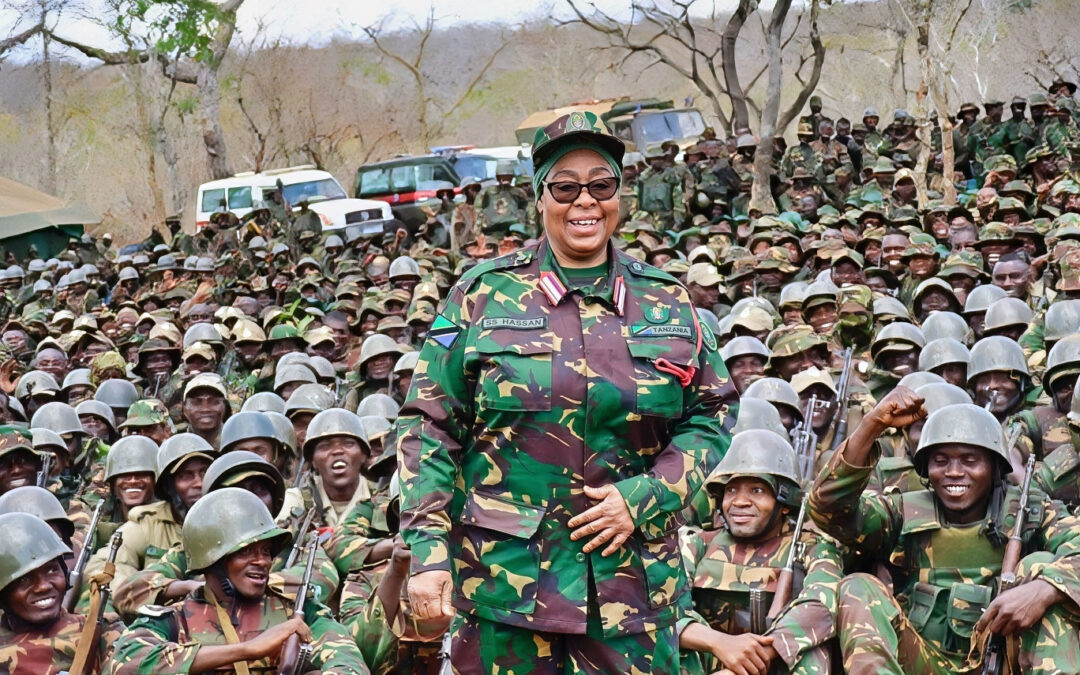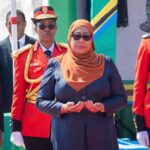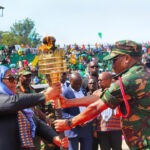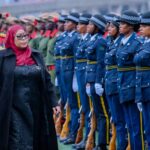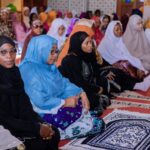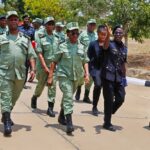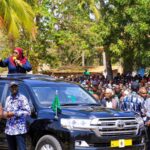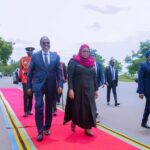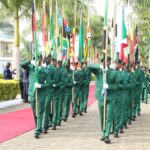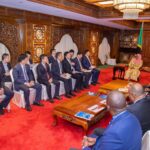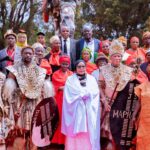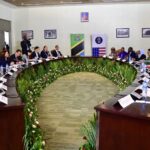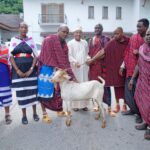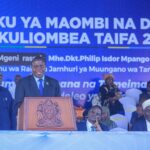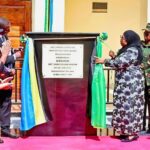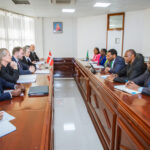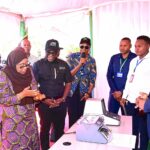Her Excellency Dr. Samia Suluhu Hassan celebrates six decades of service with a tribute to the Tanzanian armed forces
On 23 August 2024, Her Excellency Dr. Samia Suluhu Hassan, the esteemed President and Commander-in-Chief of the United Republic of Tanzania, presided over a significant event marking the 60th anniversary of the Tanzanian armed forces, Tanzania People’s Defense Force (JWTZ). The momentous event was held at Pongwe Msungura, Msata, in the Coast region, marking the culmination of a series of field exercises that exemplified the strength, dedication, and unity of the armed forces.
The Tanzania People’s Defence Forces (TPDF) A Legacy of Valor
As we approach the six-decade mark of the Tanzania People’s Defence Forces’ (TPDF) establishment, it is an opportune moment to reflect on and celebrate a legacy that is characterised by valour and patriotism. The objective of the forthcoming series of articles is to provide insight into the pivotal role of the TPDF, the Tanzania Citizens’ Defence Force (JWTZ), and the political evolution from the Tanganyika African National Union (TANU) to the Chama Cha Mapinduzi (CCM).
An investigation of the heroic struggles of Chief Mkwawa and the Maji Maji patriots against German domination is herein presented. Observe their fortitude in the face of considerable challenges, employing traditional weaponry and fostering solidarity to safeguard their African identity. Chief Mkwawa’s robust resistance system enabled him to effectively challenge foreign entities, including the German forces, which were equipped with superior weaponry. In 1891, the German Commissioner von Zelewski’s endeavour to assault Chief Mkwawa was thwarted by the latter’s 3,000-strong army, resulting in the annihilation of all German officers and soldiers in the Lugalo-Iringa conflict.
The series will provide a comprehensive analysis of the history of these forces, including their formation, challenges, and achievements. Additionally, the series will examine the political foundations that have influenced Tanzania’s history and the TPDF’s contribution to the protection of the nation’s sovereignty.
In addition, the articles will provide an account of the battles fought by Tanzanians on various fronts, including those in Madagascar, Ethiopia, Somalia, and even Japan. The narratives will not only provide an account of the strategic military engagements but also highlight the human stories of courage and resilience that have defined the Tanzanian spirit.
The tribute to the TPDF is not merely a commemorative event; it is also an opportunity to recognise the sacrifices made by its members in the pursuit of peace and stability. The series will serve as a testament to their dedication and the indelible mark they have left on Tanzania’s history.
The 60th anniversary of the JWTZ marked a significant milestone in the history of the force and served as a testament to the enduring commitment of the Tanzanian military to the safeguarding of the nation’s sovereignty and peace. Over the decades, the JWTZ has undergone significant transformation, evolving into a formidable force with a crucial role in both national defence and international peacekeeping missions. The anniversary offered a valuable chance to reflect on the achievements of the Tanzanian military to date and to consider future aspirations.
The attendance of President Samia Suluhu Hassan, Commander-in-Chief, at the event demonstrated her continued commitment to supporting the armed forces. In her address, she offered sincere and impassioned words of encouragement to the soldiers, acknowledging their dedication and sacrifices. Her speech demonstrated a profound appreciation for the unwavering discipline and resilience demonstrated by the soldiers in both peacetime and during periods of adversity.
In her address marking the sixtieth anniversary of the Tanzania People’s Defence Force, President Samia Suluhu Hassan noted that the occasion celebrates not only the history of the military but also the spirit of the nation. “The JWTZ has become a cornerstone of strength and a source of optimism for Tanzania.
I would like to commend you for your dedication to your duties and your unwavering allegiance to our country. “You have safeguarded our national frontiers, provided assistance in the wake of natural disasters, and made valuable contributions to international peacekeeping operations, thereby enhancing the prestige and reputation of our country.”
The field exercise, which constituted a pivotal aspect of the commemorative proceedings, saw the participation of a number of different groups within the JWTZ. It was an excellent illustration of tactical expertise, strategic planning and integrated coordination among the diverse units of the military. The exercise had two key objectives: firstly, to showcase the operational capabilities of the JWTZ, and secondly, to provide a training ground for enhancing the skills and readiness of the soldiers.
President Samia Suluhu Hassan seized the chance to engage in dialogue with the military personnel, gaining insight into their experiences and aspirations. Her interaction with the troops had the effect of boosting morale, thereby reinforcing the bond between the leadership and the military personnel. She emphasised the importance of continuous training and the ability to adapt to new challenges, urging the soldiers to maintain vigilance and preparedness for any eventuality.
“The global landscape is evolving rapidly, as are the challenges we face,” she noted. It is vital that we remain at the forefront of these challenges through the implementation of innovative strategies, the provision of comprehensive training programmes and the adoption of a forward-thinking approach. Our strength lies in our capacity for collective action and our ability to respond effectively to evolving circumstances. As we mark this notable accomplishment, it is crucial that we commit to developing a military force that is equipped to effectively protect our nation’s interests in the future.
The 60th anniversary celebrations were attended by a number of distinguished guests, including high-ranking officials, military veterans, and representatives from allied nations. The event served to celebrate the past achievements of the JWTZ while also reaffirming its future commitments. The attendance of international delegates demonstrated the global recognition of the JWTZ’s contributions to peace and security.
Furthermore, the anniversary celebrations included exhibitions that provided insight into the history and achievements of the JWTZ. The exhibitions provided valuable insights into the evolution of the Tanzanian military, emphasising significant milestones and contributions to national and international security. Furthermore, they provided an invaluable educational platform for the general public, facilitating a more profound comprehension of the role and importance of the Tanzanian armed forces in the country’s development.
The attendance of President Samia Suluhu Hassan, Commander-in-Chief, at the event demonstrated her continued support for the armed forces. In her address, she offered sincere and impassioned words of encouragement to the soldiers, acknowledging their dedication and sacrifices. Her speech demonstrated a deep appreciation for the unwavering discipline and resilience shown by the soldiers in both peacetime and during challenging periods.
President Samia took the opportunity to reiterate the government’s commitment to providing the military with the support it needs. She announced a series of initiatives designed to enhance the quality of life for military personnel and their families, including improvements in housing, healthcare, and educational opportunities. Furthermore, she highlighted that these measures are of the utmost importance for maintaining a motivated and efficient military force.
“The welfare of our military personnel is of the utmost importance,” she stated. “It is our intention to ensure that you and your families have access to the most appropriate facilities and opportunities. “Your service to the nation is worthy of our full support and gratitude.”
The field exercise, which constituted a pivotal aspect of the commemorative proceedings, saw the participation of a number of different groups within the JWTZ. It was an excellent example of tactical expertise, strategic planning and integrated coordination between the various units of the military. The exercise had two key objectives: firstly, it showcased the operational capabilities of the JWTZ, and secondly, it provided a training ground for enhancing the skills and readiness of the soldiers.
As the celebrations drew to a close, President Samia expressed her gratitude to all those who have contributed to the success of the JWTZ over the years. Furthermore, she acknowledged the sacrifices made by military personnel and their families, paying tribute to those who have lost their lives in the line of duty.
“To the families of our fallen heroes, we are indebted to them for their ultimate sacrifice, a debt that can never be repaid,” she said. “Their sacrifice serves as a reminder of the cost of our freedom and the collective responsibility we all share in preserving it.”
The 60th anniversary of the Tanzania People’s Defence Force was a significant event that celebrated past achievements and highlighted future potential. Under the guidance of President Samia Suluhu Hassan, the JWTZ is well-positioned to maintain its tradition of excellence, adapting to emerging challenges and continuing to serve as a reliable guardian of Tanzania’s peace and security.
HISTORY OF THE JWTZ -TANZANIA CIVIL DEFENSE ARMY
The history of work and activities related to protection and security in Tanzania has its roots in the practices of our ancestors. A variety of communities, situated in different geographical areas within the country, had developed traditional forms of collective protection that encompassed the entire community. The traditional defence mechanisms of the time formed the foundation of security for all communities. The weaponry employed by our ancestors was basic, comprising bows, spears, sickles, swords and other tools used for the protection of their communities. Each tribe had a method of training its younger members in weaponry, after which they were entrusted with the responsibility of safeguarding their communities.
Following the Industrial Revolution in Europe during the nineteenth century, Africa experienced significant political, economic and social transformations. The Berlin Conference, held between 1884 and 1885, led to significant political, economic and military changes in African countries. This marks the beginning of numerous countries in Africa being placed under the control of foreign forces.
Following the Berlin Conference, Germany was granted legitimacy to rule Tanganyika. This resulted from the partitioning of the African continent into territories without the consent of the African people. The German military initiated a campaign to dismantle the administrative structures of the various tribes in this country with the objective of establishing a unified administration and colonial army. The German movement prompted some tribes to engage in armed conflict with the German Army, as the German regime sought to dismantle the entire system of traditional defence, politics and local economy.
The war of Chief Mkwawa in 1890 provides an illustrative example of the resilience of certain tribes in this country, despite their use of inferior weaponry. Nevertheless, a few years after Chief Mkwawa was defeated in the conflict with the Germans, the water war (Maji Maji) commenced. This further example of resistance against foreign domination, which was fought from 1905 to 1907, had a significant impact on the history of Tanganyika. Despite utilising traditional weapons, the tribes demonstrated resilience in resisting the invasion of foreign forces. However, it was their unified stance that enabled them to stand firm in their fight for African identity.
The decolonisation period saw significant changes in the field of defence and security, with the right of Africans to defend themselves being revoked. This marked the advent of modern armies in this country.
Following the conclusion of the First World War, which lasted from 1914 to 1918, the military movement in this country entered a new phase. The German forces were defeated and lost control of the colonies they were ruling, which was one of the conditions for losing the war. Subsequently, Tanganyika was placed under British supervision and under the auspices of the United Nations Security Council. From that point onwards, the official army that led Tanganyika was known as the King’s African Rifles (KAR).
Notwithstanding the fact that the KAR was the army of Tanganyika, which was under British control, the system of recruitment and employment within the army was not officially recognised. Young people were required to perform defence work when necessary. In periods of peace, young people engaged in productive activities, including those directed by African traditions and customs, which assigned roles to each member of the community. However, during the colonial period, the traditional army continued to exist in every tribe and community, as the KAR was not present in every region of the country.
Some tribes had developed a more robust defensive structure than others. Notable examples include the Wahehe, Waniamwezi, Sukuma, Maasai and Kuria tribes. Such tribes had in place a system of tribal protection.
By way of illustration, the Maasai tribe had a highly effective defensive system. Training was provided for the protection and security of the tribe, with the content and level of instruction tailored to the age and maturity of the individual. Similarly, the Sukuma tribe had a robust system in place to safeguard its security and protect its members. This entailed congregating in villages to identify one another and devise collective defensive strategies for the tribe as a whole. Young people were brought together to learn the necessary skills for combat, including the accurate aiming and throwing of arrows and spears.
It was the fundamental responsibility of the community, both before and during the colonial period, to ensure the safety and security of all members. It was the responsibility of every member of the community, irrespective of their physical condition, to ensure the protection of every other member of the community.
Mtemi Mirambo of Unyanyembe was among the first to voice opposition to the arrival of colonial rule at the beginning of the 19th century. The considerable military capabilities of numerous tribes in Tanganyika became evident during the anti-colonial movements preceding and following the General Conference in Berlin between 1884 and 1885, as well as at the advent of the 20th century.
The leader of the Wahehe tribe, Chief Mkwawa, successfully resisted German rule for approximately three years, ultimately prevailing in 1891. Chief Munyigumba, the inaugural leader of the Wahehe tribe, unified over 100 clans between 1860 and 1880, thereby establishing himself as the preeminent figure within the tribe. His strategic thinking was further demonstrated by his ability to successfully repel external incursions into his domain.
Until his death in 1880, Munyigumba was instrumental in safeguarding the interests of the Wahehe tribe. Following the passing of Munyigumba, Chief Mkwawa assumed leadership and was able to maintain the tribe’s resilience against external threats. The name ‘Mkwawa’ was derived from the word ‘Mkwavinyika’, which means ‘land grabber’, due to his effective military strategy which enabled him to expand his empire.
However, Chief Mkwawa selected Kalenga as his headquarters, where he proceeded to construct a 13-kilometre-long fortress with a 3.5-metre-high wall. The construction was completed in accordance with the agreed timeframe.
Due to the robust system that Chief Mkwawa had in place, he was able to effectively challenge the arrival of foreign entities and engage in combat with the Germans, who had superior weaponry. In July 1891, German Commissioner Emil Von Zelewski led a force of approximately 320 African soldiers in an attempt to attack Chief Mkwawa due to the resistance of the latter’s army. However, he was unable to gain control of the situation due to the strength of Mkwawa’s army, which consisted of approximately 3,000 soldiers. All officers and soldiers of the German Army were killed in the fighting that took place in the Lugalo-Iringa area.
However, on 28 October 1894, the Germans, under the command of Colonel Friedrich Von Schele, engaged with Mkwawa in his fortress in Kalenga. Despite the Germans’ best efforts, the leader was able to evade capture. Mkwawa subsequently set up an ambush, which continued until July 1898. By this point, he had come to realise that he was surrounded by enemies and therefore took the decision to end his own life before being captured by the German colonists.
The Water War (Maji Maji) was instigated by the Southern tribes, who were opposed to German governance. The conflict began in July 1905 and continued until August 1907, initiated by the Matumbi of the Nandete region in Kilwa District. The war leader was Kinjekitile Ngwale, also known as Bokero. He provided his followers with a potion, which he informed them would render German bullets ineffective.
The Kinjekitile troops advanced at an unprecedented pace, continuing to engage in combat with the German Army. The conflict involved a number of different communities, including the Wangindo, Wandendeule, Wabena, Wamwela and Wangoni tribes. The Water War was a conflict against the German colonial authorities, who had ruled Tanganyika since 1885 and expropriated land and disrupted the lives of the local population.
Despite the best efforts of these tribes, the Germans were ultimately victorious due to their superior weaponry. In the end, all the leaders of the conflict were apprehended and executed by the Germans.
Following the Berlin Conference of 1884 to 1885, which was convened by Chancellor Otto Von Bismark of Germany, Tanganyika came under German control. During the colonial period, the Germans established a force that they designated a self-defence force, comprising between 2,500 and 3,000 soldiers of African origin. The soldiers were led by eight German officers, with the remaining personnel not holding officer rank. As time progressed, the recruitment of citizens continued, resulting in the formation of a military force comprising 12,000 soldiers prior to the advent of the First World War. Those who had been displaced and had enlisted in the army were designated as ‘soldats’, with a select few attaining the rank of corporal.
The training programme for African soldiers was based on the German curriculum and delivered in Kiswahili. Dar es Salaam was a pivotal recruitment and training hub for the colonial army. The German forces were deployed to a number of locations across the country, including Arusha, Kilimatinde Masoko, Ujiji, Bukoba, Tabora, Dar es Salaam, Mahenge, Kondoa and Mwanza.
However, during the period of German rule, numerous centres previously designated as DOMA were subsequently renamed British Overseas Management (BOMA) by the British. The BOMA were constructed in the district from 1889 onwards with the dual objective of controlling population growth and managing administrative activities. The stations were set up for defensive purposes and were staffed by a military guard. In the wake of the conflict between Chief Mkwawa and Majimaji, substantial fortifications were erected in Iringa, Mahenge and Songea to facilitate colonial governance.
During the First World War (1914-1918), the German colony of Tanganyika remained under German control for a brief period. In the early stages of the conflict, the German forces were sufficiently robust to gain ground and penetrate the local empires. The British Army’s decision to attack the Germans in the East African Empire prompted a robust response from General Paul von Lettow-Vorbeck, particularly following the arrival of a German ship at Tanga in 1914.
However, the German Commander’s tactics indicated an intention to reinforce the support force. Nevertheless, Lettow-Vorbeck persisted in his campaign against the British, successfully imparting knowledge to some soldiers regarding the utilisation of the battlefield, identification of optimal combat zones, and the execution of strategic assaults.
Furthermore, the wives of the soldiers played an active role in the attacks. Lettow-Vorbeck was able to lead 15,000 soldiers, including 70 support troops, in the aforementioned movement. The aforementioned soldiers were preparing to face approximately 160,000 troops belonging to the British Empire, under the command of General Jan Smuts of South Africa.
Nevertheless, in 1916 Smuts was successful in capturing the northern borders, which were subsequently placed under the control of the British Empire. At that time, the Belgian Army, under the command of General Charles Tombeur, arrived in Tabora from Western countries and was required to enter the Kagera region from Uganda. Lettow-Vorbeck’s troops demonstrated remarkable proficiency and cohesion, enabling him to sustain a four-year campaign before finally being vanquished in 1918. This resulted in their return to Europe.
Subsequently, the personnel who had been taken from Tanganyika were transferred from the vanquished German Army to the British Army, which was designated the King’s African Rifles (KAR). The KAR army continued to expand in size and influence within the Confederation of African Union. The KAR was comprised of two forces, with soldiers drawn from Tanganyika, Kenya and Uganda. Once hostilities had ceased, the KAR had a strength of between 400,000 and 500,000 soldiers from East Africa.
British forces made their inaugural appearance in Tanganyika during the First World War, initiating an offensive on Dar es Salaam with the destroyer HMS Astraea on 8 August 1914. This resulted in the seizure of a commercial vessel. The Germans proceeded to capture the port of Dar es Salaam, which resulted in a state of unrest within the port. In 1916, the port was returned to British control.
Following a malfunction in the port due to ongoing conflict, German merchants and their vessel, the SMS Konigsberg, returned to Dar es Salaam and entered via the Rufiji River to repair an engine that had encountered difficulties. Subsequently, on 11 July 1915, the British successfully identified the location of the SMS Koningsberg and launched a significant attack on it in the Rufiji River, resulting in its destruction.
Meanwhile, on Lake Tanganyika, there were intense clashes between German, British and Belgian sailors. By the end of 1915 and 1916, control of the river was being contested. The ship SMS Kingani was the first to be destroyed and captured, while HMS Foji changed course. The second attack on the ships SMS Hedwing Von Wissman and SMS Graf Von Goetzen was followed by an attack by Belgian warplanes, which resulted in the complete destruction of both vessels. In 1921, repairs commenced once more in Lake Tanganyika, with the vessel being renamed MV Liemba (Graf Von Goetzen) in 1927. The Liemba ship is still in operation today on Lake Tanganyika.
In response to the reinforcement of enemy positions on the beaches, the German forces were compelled to retreat through Lake Tanganyika, thereby allowing the British and Belgians to assume control. The population of Tanganyika was engaged in combat on all sides and underwent training to operate the ships.
The King’s African Rifles, a military unit based in Tanzania
Following the conclusion of the First World War, the British were granted authority to lead Tanganyika as a condition for Germany’s defeat in the First World War, as set forth by the United Nations in early 1920. The office of the head of the empire was established in this country and the territory was designated the Tanganyika Empire. Following the outbreak of the Second World War in 1939, the 6th KAR force in East Africa was prepared for combat following Italy’s entry into the war in 1940.
Servicemen from Tanganyika played a prominent role in the Second World War, fighting on the side of England. The initial engagement took place in Somalia, where the KAR force traversed 277 kilometres over the course of 53 hours, advancing from Kenya to Abyssinia between 1940 and 1941. Their efforts resulted in the capture of Addis Ababa, a city of significant strategic importance.
However, the sixth battalion of KAR was accompanied by the 2nd battalion of Zanzibar, which was responsible for providing initial medical assistance in collaboration with the medical corps of East Africa. Subsequently, the unit proceeded to Ceylon, where it merged with the 14th (XIV) unit, which had been assembled for combat operations against the Japanese Army in Burma. Following the conclusion of the Second World War, Tanganyika was designated a British colony on 13 December 1946. This resulted in substantial shifts in the regional landscape, including the rise of political movements and the strengthening of the British military footprint.
Following the Second World War, responsibility for defence and security activities was assumed by the British. To consolidate its position in the country, KAR took the initiative of enrolling young people from Tanganyika in its ranks.
Tanganyika Rifles
Tanganyika became an independent nation on 9 December 1961. At the independence ceremony, the government of Tanganyika announced its intention to change the name of the army from the King’s African Rifles (KAR) to the Tanganyika Rifles (TR). Despite the elegant nomenclature that reflected the name of the newly independent country, the TR retained the same colonial system. Lieutenant Colonel Rowland Mans, a British officer, commanded the sixth contingent, which was stationed in Dar es Salaam.
Lieutenant Colonel Harry Martsons assumed command of the second force, stationed in Kalewa (Mirambo Tabora), in 1963. Martsons had previously served as an officer in the KAR Army. At the same time, a single company was deployed to Nachingwea in 1963 under the command of Major Morris Temple, a white officer. The objective was to establish a new unit, designated Gonder, in commemoration of the soldiers who had fought and prevailed in Burma.
Zanzibar gained independence from Britain on 10 December 1963, following a contentious electoral process. Mohammed Shamte, a member of the Zanzibar royal family, was appointed Prime Minister. However, Zanzibar remained under the authority of Sultan Jamshid bin Abdullah, who was deposed by a popular uprising on 12 January 1964.
The revolution was initiated by the majority of Africans who were opposed to the rule of Sultan Abdullah. The overthrow of the Sultanate regime by the African population of Zanzibar, under the leadership of Hayati Abeid Amani Karume, resulted in the establishment of a Revolutionary Council that has remained in power until the present day.
Furthermore, the leaders of Tanganyika and Zanzibar demonstrated astute political judgement by reaching a mutually beneficial agreement on 26 April 1964, which marked the end of the Zanzibar Revolution. The countries of Tanganyika and Zanzibar were unified to form the United Republic of Tanzania, a single nation-state. Subsequently, the two countries were unified, with eleven areas, including defence matters, being incorporated. It is therefore clear that the armies of these two countries were officially unified on 24 July 1964.
The year 1964 was a pivotal one in the history of Tanzanian politics, marked by the rebellion of the soldiers of the Tanganyika Rifles on 20 January 1964. Furthermore, the TR was officially dissolved on 25 January 1964, paving the way for the establishment of the Tanzanian People’s Defence Force on 1 September. The changes that occurred in Tanganyika were reflected in Zanzibar, albeit in a different form.
The Zanzibar Liberation Army was established on 12 January 1964. As part of the process of uniting the two countries, the Army merged with the Tanganyika Military Force for a period of time and subsequently established a new Army, the Tanzanian People’s Defence Force.
The uprising, which commenced on 20 January 1964, originated at Collito Barracks (Lugalo, Dar es Salaam) and subsequently spread to Kalewa Barracks, which was located in Tabora. However, the rebellion did not conclude at Tabora; it also encompassed the recently established company that had been deployed to Nachingwea, which was intended to serve as the basis for a third force in Tanzania. Additionally, the soldiers stationed at Nachingwea also participated in the insurrection. The January 20 rebellion has been attributed to a number of different factors.
In a nationally broadcast speech, the Commander-in-Chief and President of Tanganyika at the time, Mwalimu Nyerere, informed the public that the soldiers had various motives for the rebellion. These included the desire of African soldiers to accelerate the Africanisation policy within the Tanganyika Army Rifles, with the goal of removing white officers and soldiers from the army and allowing African officers and soldiers to assume leadership roles within the independent Tanganyika Army.
A further issue identified as a cause for concern among these TR soldiers was the possibility of salary increases. The remuneration offered to military personnel was structured according to a grading system that resulted in African officers and soldiers receiving lower salaries than their white counterparts. It is notable that the salaries of white officers and soldiers were, in fact, higher than those of their African counterparts. Furthermore, it was alleged that the soldiers were motivated by a desire to enhance their quality of life and working conditions. However, following negotiations spearheaded by the Minister of Foreign Affairs and Defence, Mr Oscar Kambona, the government agreed to implement salary increases and improve the working environment.
Once the rebellion had been quelled through negotiations, the government sought assistance from British forces in order to suppress the remaining resistance. The government of Tanganyika elected to request assistance from the British government, given the relative ease with which they could deploy forces, given that the officers and soldiers in question were being held by rebels. Another rationale for requesting British intervention was the continued leadership of the Tanganyika Rifles by British officers and soldiers. The commander of the Tanganyika Army during the rebellion was Brigadier General Doglous, a British officer.
In consequence of the suppression of the insurrection with the assistance of the British Commandos, all those who had played a role in encouraging their colleagues to participate in the insurrection were removed from the Army. Similarly, those who had assumed leadership roles in other rebellions were also prosecuted for rebellion. Those officers and leading soldiers who had not participated in the rebellion were retained within the army for a period of time, during which the army was renamed from Tanganyika Rifles to Tanganyika Military Force. The designation was employed for a relatively brief period until the formation of the new army on 1 September 1964, which was designated the Tanzanian People’s Defence Force. This designation remains in use to the present day.
The recruitment of soldiers by the colonists entailed a process of measuring the health and height of young people in each village with the objective of enlisting them in the army. Following the dissolution of the Tanganyika Rifles due to the uprising, Mwalimu Julius Nyerere, the Commander-in-Chief and President of Tanganyika, called upon the younger members of the Tanganyika African National Union (TANU) to register at the TANU offices for the formation of a new army. Furthermore, those who had been enlisted in the Army Building a Nation were also enrolled in the new army.
In contrast to the methods employed by the colonial authorities to enlist young people in the army, the new army was constituted exclusively of those who demonstrated patriotism and loyalty to their country. Young members of the Tanganyika African National Union (TANU) were accorded significant status within the nascent army, reflecting the pervasive influence of the party throughout the country and its reputation as a staunchly patriotic organisation.
The training programme for the new recruits to the army commenced on 3 March 1964 at the Mgulani camp and was completed on 1 September of the same year. Approximately 1,000 soldiers took the oath in the presence of the Commander-in-Chief and President of Tanzania, Mwalimu Julius Nyerere. Additionally, the ceremony was attended by President Abeid Amani Karume, who was the Vice President at the time.
Upon completion of their initial training, the new recruits were officially inducted into the Tanzania People’s Defence Force (JWTZ). This event marked the inception of the Tanzanian People’s Defence Force, which has since undergone a lengthy process of development.
Moreover, the process of reinforcing the fledgling army commenced with remarkable swiftness following the attainment of independence, with the objective of attaining the national aspiration of possessing an independent military force. Training for officers was conducted on a provisional basis in a number of countries with which Tanzania had friendly relations, including Canada, England, Israel, India, China and Pakistan. The government of Tanzania pursued the goal of achieving independence through the establishment of an independent army.
In light of the necessity for a corps of officers and soldiers who possess the requisite qualifications and training, the government of Tanganyika resolved to dispatch as many recruits as possible to the country for the purpose of undergoing the requisite training. While the financial outlay involved in sending soldiers abroad was considerable, the necessity was overwhelming, and the country was therefore compelled to pursue the rapid consolidation of its military capabilities. In any case, the expeditious production of a corps of officers was a prerequisite.
It is noteworthy that prior to and following the attainment of independence, the country was afforded the opportunity to dispatch a single student officer on an annual basis to England for training. This initiative would have required approximately fifty years for Tanzania to produce the same number of officers. TANU adopted an alternative approach, sending 15 members of the party to undertake officer training in Israel in 1963.
Subsequent to the establishment of JWTZ, the Army proceeded to develop the same three infantry units, although the names were altered to align with the image of an Army that was consistent with the environment of independent Tanzania and those camps that were utilising foreign names. From this point onwards, the camps were designated with patriotic names, with examples including Collito Barracks, which was named Lugalo in commemoration of Chief Mkwawa of Iringa, who engaged in combat with the Germans and ultimately succeeded in killing them in the Lugalo region. Kalewa Tabora Camp was named in honour of Chief Milambo, in recognition of his unwavering resistance to colonialism.
TANZANIA CITIZENS’ DEFENSE FORCE (JWTZ)
The JWTZ was established on 1 September 1964 with the objective of safeguarding the country’s independence and the integrity of its borders, as set forth in the United Republic of Tanzania’s constitution.
Vision of JWTZ
The Tanzanian military is comprised of a small but highly trained and equipped force of leaders and professionals, whose primary responsibility is to defend the country.
The responsibility of JWTZ is to safeguard the nation and defend the interests of the Tanzanian people, provide assistance to civil authorities and facilitate the achievement of national and international objectives.
The fundamental responsibilities of JWTZ can be broadly classified into the following categories:
• The protection of the Constitution and the freedom of the United Republic of Tanzania.
•The protection of the borders of the United Republic of Tanzania is of paramount importance.
• It is imperative that training and exercises are conducted on a continuous basis in order to ensure preparedness for combat at all times.
• The dissemination of information to the general public regarding national defence activities.
• The provision of humanitarian aid and rescue services in collaboration with civil authorities in the context of disasters.
• The Nation Building Force (JKT) is engaged in the promotion of independent education and production.
• Involvement in international peacekeeping operations.
The Tanzanian People’s Defence Force (TPDF) persists in its role of maintaining peace and security in a multitude of conflict zones, both within and beyond the African continent, in accordance with the mandates of the United Nations (UN) and the African Union (AU). Furthermore, in addition to contributing personnel to peace protection units, the JWTZ has also provided officers and soldiers as peace observers (MILOBS) and officers (SO) in various missions.
The African Union–United Nations Mission in Darfur (UNAMID) represents a joint peacekeeping operation between the African Union and the United Nations.
Since 2008, JWTZ has been engaged in this mission, deploying a contingent of 800 personnel on a one-year rotational basis. The aforementioned battalion is designated as TANZBATT, comprising units 1 to 10.
The Tanzanian People’s Defence Force (TPDF) has been engaged in peacekeeping operations in Lebanon under the auspices of the United Nations (UN) since 1978. These operations are conducted under the auspices of the United Nations Interim Force in Lebanon (UNIFIL).
In February 2007, Tanzania deployed its inaugural contingent of peacekeepers. The peacekeepers were assigned a vast expanse of responsibility in Southern Lebanon, which presented a significant challenge for officers and soldiers alike.
In light of the considerable expanse of the region, it has become evident that the existing capacity is insufficient. As a result, in 2011, Southern Lebanon was divided into three principal zones: The headquarters of UNIFIL are located in Naqoura, while Sector West is situated in Shama and Sector East is located in Marjayoun.
In 1993, JWTZ participated in peacekeeping operations in Liberia, providing a contingent in response to a request from the Economic Community of West African States (ECOWAS) and the African Union (AU). Subsequently, JWTZ was reassigned to another protection area, designated Sector West, which resulted in the addition of a second company to that sector. Concurrently, Sector East was allocated to the Indonesian Police Force.
The Tanzanian People’s Defence Force (TPDF) has continued to fulfil the role of a peacekeeping force in a number of conflict zones both within and beyond the African continent, operating under the auspices of the United Nations (UN) and the African Union (AU). In addition to providing personnel for the protection of peace, JWTZ has also deployed officers and soldiers as peace observers (MILOBS) and officers (SO) in various missions.
United Nations Stabilization Mission in the Democratic Republic of Congo
In 2013, JWTZ deployed the inaugural contingent of 1,256 personnel to this mission, with ongoing contributions to the present day. This contingent, designated as TANZBATT-1 DRC to TANZBATT-3 DRC, remains engaged in operations within the country.
In conclusion, the celebrations at Pongwe Msungura were an appropriate acknowledgement of the courage, dedication, and resilience of the Tanzania People’s Defence Force. As the nation anticipates the next phase of its military history, the words of President Samia provide a beacon of guidance, inspiring the soldiers to maintain the highest standards of service and honour in the years to come.
The subsequent session of Part 1 will present a more comprehensive historical overview of the Tanzania People’s Defence Forces (TPDF).
Tanzania Media
- The Nineteenth Parliament, Second Session: A Milestone for Tanzania and Zanzibar’s Democratic Journey - 17 April 2025
- Zanzibar’s Healthcare Revolution: Laparoscopic Surgery at Moka Lumumba Referral Hospital - 17 April 2025
- The Tanzania Parliament’s Landmark Passage of Seven Bills: A Step Towards Progress and Accountability - 17 April 2025

